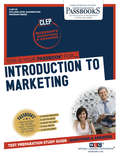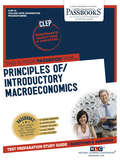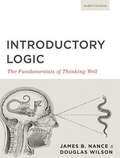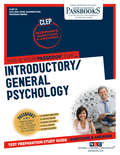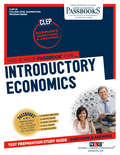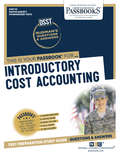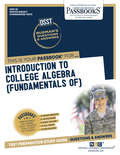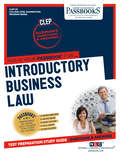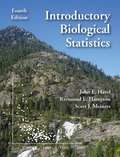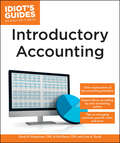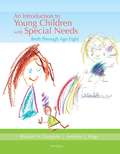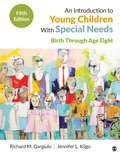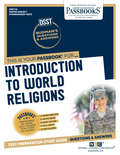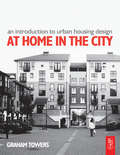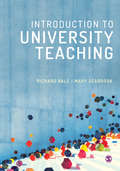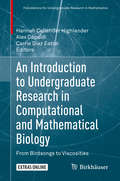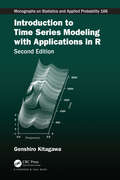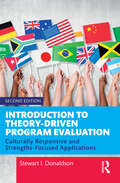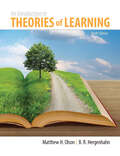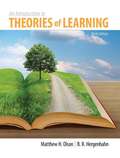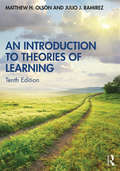- Table View
- List View
INTRODUCTORY MARKETING: Passbooks Study Guide (College Level Examination Program Series (CLEP))
by National Learning CorporationThe College Level Examination Program (CLEP) enables students to demonstrate college-level achievement and earn college credit in various subject areas based on knowledge acquired through self-study, high school and adult courses, or through professional means. The CLEP Introductory Marketing Passbook® prepares you by sharpening knowledge of the skills and concepts necessary to succeed on the upcoming exam and the college courses that follow. It provides a series of informational texts as well as hundreds of questions and answers in the areas that will likely be covered on your upcoming exam, including but not limited to: buyer behavior and consumption patterns; wholesale and retail markets; economic and social roles of marketing; and more.
INTRODUCTORY MACROECONOMICS: Passbooks Study Guide (College Level Examination Program Series (CLEP))
by National Learning CorporationThe College Level Examination Program (CLEP) enables students to demonstrate college-level achievement and earn college credit in various subject areas based on knowledge acquired through self-study, high school and adult courses, or through professional means. The CLEP Introductory Macroeconomics Passbook® prepares you by sharpening knowledge of the skills and concepts necessary to succeed on the upcoming exam and the college courses that follow. It provides a series of informational texts as well as hundreds of questions and answers in the areas that will likely be covered on your upcoming exam, including but not limited to: government and economy; money and banking; taxation; economic growth and development; and more.
Introductory Macro Economics class 12 - CBSE Board
by Sandeep GargSalient Features of the Book: Each topic has been written in accordance with the latest guidelines issued by CBSE, The concepts have been systematically explained through use of diagrams, tables and examples, HOTS Questions with answers have been given at the end of each chapter to enhance the student’s understanding, analytical ability and interpretation, Multiple Choice Questions (MCQs) with answers have been given at the end of each chapter, Each chapter contains True and False Questions and NCERT textbook questions (with hints), Value Based Questions with answers have been given in the revision section, Practical Problems have the considerable weightage in the Board Examination To have a competitive edge, large number of comprehensive solved and unsolved practical problems have been given and Power Booster Section has been provided for knowledge enrichment of the students.
Introductory Logic:The Fundamentals of Thinking Well (5th Edition.)
by James B. Nance Douglas WilsonThis book intends to help students in establishing a concrete and applicable knowledge of propositional arguments.
INTRODUCTORY / GENERAL PSYCHOLOGY: Passbooks Study Guide (College Level Examination Program Series (CLEP))
by National Learning CorporationThe College Level Examination Program (CLEP) enables students to demonstrate college-level achievement and earn college credit in various subject areas based on knowledge acquired through self-study, high school and adult courses, or through professional means. The CLEP General Psychology Passbook® prepares you by sharpening knowledge of the skills and concepts necessary to succeed on the upcoming exam and the college courses that follow. It provides a series of informational texts as well as hundreds of questions and answers in the areas that will likely be covered on your upcoming exam, including but not limited to: physiology and behavior; learning; motivation and emotion; lifespan development; behavior; social psychology; and more.
INTRODUCTORY ECONOMICS: Passbooks Study Guide (College Level Examination Program Series (CLEP) #Clep-41)
by National Learning CorporationThe College Level Examination Program (CLEP) enables students to demonstrate college-level achievement and earn college credit in various subject areas based on knowledge acquired through self-study, high school and adult courses, or through professional means. The CLEP Introductory Economics Passbook® prepares you by sharpening knowledge of the skills and concepts necessary to succeed on the upcoming exam and the college courses that follow. It provides a series of informational texts as well as hundreds of questions and answers in the areas that will likely be covered on your upcoming exam.
INTRODUCTORY COST ACCOUNTING: Passbooks Study Guide (DANTES Subject Standardized Tests (DSST))
by National Learning CorporationThe DSST Subject Standardized Tests are comprehensive college and graduate level examinations given by the Armed Forces, colleges and graduate schools. These exams enable students to earn college credit for what they have learned through self-study, on the job, or by other non-traditional means. The DSST Introductory Cost Accounting Passbook® prepares candidates for the DSST exam, which enables schools to award credit for knowledge acquired outside the normal classroom environment. It provides a series of informational texts as well as hundreds of questions and answers in the areas that will likely be covered on your upcoming exam.
INTRODUCTORY COLLEGE ALGEBRA: Passbooks Study Guide (DANTES Subject Standardized Tests (DSST) #Dantes-55)
by National Learning CorporationThe DSST Subject Standardized Tests are comprehensive college and graduate level examinations given by the Armed Forces, colleges and graduate schools. These exams enable students to earn college credit for what they have learned through self-study, on the job, or by other non-traditional means. The DSST Introductory College Algebra Passbook® prepares candidates for the DSST exam, which enables schools to award credit for knowledge acquired outside the normal classroom environment. It provides hundreds of questions (with solutions) in the areas that will likely be covered on your upcoming exam, including but not limited to: rational expressions; linear and quadratic equations; functions; graphing; and more.
INTRODUCTORY BUSINESS LAW: Passbooks Study Guide (College Level Examination Program Series (CLEP) #Clep-20)
by National Learning CorporationThe College Level Examination Program (CLEP) enables students to demonstrate college-level achievement and earn college credit in various subject areas based on knowledge acquired through self-study, high school and adult courses, or through professional means. The CLEP Introductory Business Law Passbook® prepares you by sharpening knowledge of the skills and concepts necessary to succeed on the upcoming exam and the college courses that follow. It provides hundreds of questions and answers in the areas that will likely be covered on your upcoming exam, including but not limited to: history of American law; the American legal system; meaning and formation of contracts; and more.
Introductory Biological Statistics
by John E. Havel Raymond E. Hampton Scott J. MeinersCourses such as statistics, which develop quantitative analytical skills, remain important preparation for careers in the sciences and graduate school. The book supports teaching a one-semester-long course in statistics with a focus on biological examples and applications. Students need not have any prior exposure to probability and statistics, although college algebra is recommended. The book has added concept checks in all of the chapters, as well as more definition boxes and examples. A number of substantive changes has been made in this new edition. The exercises in each chapter have now been sorted into two groups: practice exercises (with solutions in appendix B) and homework exercises (solutions available only to instructors).
Introductory Accounting (Idiot's Guides)
by David H. Ringstrom Gail Perry Lisa A. BuckiAccurate accounting is the key to a successful business. But when you&’re dealing with assets and liabilities, profit and loss, and debits and credits, juggling all the numbers can quickly get confusing. Introductory Accounting gives you everything you need to know about basic financial accounting to manage your dollars and cents and keep your accounts in order. Ideal for small businesses, as well as any large company bookkeeper, this book covers:• Structuring your business and choosing an accounting method.• Setting up an accounting system and basic operating procedures (tracking sales, determining costs, managing cash, etc.).• Creating employee records, maintaining a payroll system, and accounting for benefits.• Keeping tax and benefit records.• Reporting costs.• Closing out cash journals and employee accounts at month-end and balancing ledgers.• Preparing month-end and year-end statements and reports. • Producing a balance sheet and monthly profit-and-loss (P&L) statements.• Using accounting software.
An Introduction to Young Children with Special Needs Birth Through Age Eight
by Jennifer L. Kilgo Richard M. GargiuloAN INTRODUCTION TO YOUNG CHILDREN WITH SPECIAL NEEDS offers a thorough introduction to the educational policies, programs, practices, and services specific to infants, toddlers, and preschoolers who demonstrate delays and disabilities. It also offers information about youngsters who exhibit signs of being at-risk for future programs in learning and development. Through a host of proven learning techniques, a website, and additional related resources, readers are guided to a full understanding of important theoretical and philosophical foundations in serving children whose learning is delayed. These include authentic assessments, cultural sensitivity and competence, activity-based interventions, and developmentally and individually appropriate practices. The book emphasizes instructional strategies necessary for creating inclusive learning environments, and offers recommendations throughout for using technology in the learning environment.
An Introduction to Young Children With Special Needs: Birth Through Age Eight (Education Ser.)
by Richard M. Gargiulo Dr Jennifer L. KilgoAn Introduction to Young Children with Special Needs: Birth Through Age Eight is a comprehensive introduction to educational policies, programs, practices, and services for future practitioners serving young children with delays or disabilities in early intervention-early childhood special education (EI-ECSE). Thoughtfully addressing the needs of children at risk for learning or development delays or disabilities, revered authors Richard M. Gargiulo and Jennifer L. Kilgo offer evidence-based interventions and instructional techniques that provide students with a broad understanding of important theoretical and philosophical foundations, including evidence-based decision making, developmentally appropriate practices, cultural responsiveness, and activity-based intervention.
An Introduction to Young Children With Special Needs: Birth Through Age Eight (Education Ser.)
by Richard M. Gargiulo Dr Jennifer L. KilgoAn Introduction to Young Children with Special Needs: Birth Through Age Eight is a comprehensive introduction to educational policies, programs, practices, and services for future practitioners serving young children with delays or disabilities in early intervention-early childhood special education (EI-ECSE). Thoughtfully addressing the needs of children at risk for learning or development delays or disabilities, revered authors Richard M. Gargiulo and Jennifer L. Kilgo offer evidence-based interventions and instructional techniques that provide students with a broad understanding of important theoretical and philosophical foundations, including evidence-based decision making, developmentally appropriate practices, cultural responsiveness, and activity-based intervention.
INTRODUCTION TO WORLD RELIGIONS: Passbooks Study Guide (DANTES Subject Standardized Tests (DSST))
by National Learning CorporationThe DSST Subject Standardized Tests are comprehensive college and graduate level examinations given by the Armed Forces, colleges and graduate schools. These exams enable students to earn college credit for what they have learned through self-study, on the job, or by other non-traditional means. The DSST Introduction to World Religions Passbook® prepares candidates for the DSST exam, which enables schools to award credit for knowledge acquired outside the normal classroom environment. It provides a basic reference section of Biblical quotations as well as hundreds of questions and answers in the areas that will likely be covered on your upcoming exam, including but not limited to: basics dimensions of religion; knowledge of basic facts and terminology; understanding concepts and principles; Hinduism; Buddhism; Judaism; Christianity; Islam; and more.
Introduction to Vygotsky
by Harry DanielsThis thoroughly updated third edition provides students with an accessible overview of Vygotsky’s work, combining reprints of key journal and text articles with rich editorial commentary. Lev Vygotsky provided the twentieth century with an enticing mix of intellectual traditions within an attempt to provide an account of the social formation of the mind. His legacy is an exciting, but at times challenging fusion of ideas. Retaining a multi-disciplinary theme, Introduction to Vygotsky, 3rd edition begins with a review of current interpretations of Vygotksy’s original work. Harry Daniels goes on to consider the development of Vygotsky’s work against a backdrop of political turmoil in the developing USSR. Major elements explored within the volume include the use of the 'culture' concept in social development theory, the development of means of describing social life, the concept of mediation, and implications for teaching, learning and assessment This book will be essential reading for Vygotskian students in developmental psychology, education and social sciences, as well as to students on specialised courses on cultural, cross-cultural and socio-cultural psychology, philosophical psychology, philosophy of science, history of psychology and Soviet/Russian history.
Introduction to Urban Housing Design: At Home In The City
by Graham TowersThis clear and concise guide is the ideal introduction to contemporary housing design for students and professionals of architecture, urban design and planning. With the increasing commitment to sustainable design and with an ever-increasing demand for houses in urban areas, housing design has taken on a new and crucial role in urban planning. This guide introduces the reader to the key aspects of housing design, and outlines the discussion about form and planning of urban housing. Using chapter summaries and with many illustrations, it presents contemporary concerns such as energy efficient design and high density development in a clear and accessible way. It looks at practical design solutions to real urban problems and includes advice on reclamation and re-use of buildings. The guidance it presents is universally relevant. Part two of the book features current case studies that illustrate the best in high density, sustainable housing design providing the reader with design information, and design inspiration, for their own projects.
Introduction to University Teaching
by Richard Bale Mary SeabrookThe essential guide to teaching and learning in higher education for early career academics, postgraduate researchers, graduate teaching assistants and professional services staff. This accessible text offers practical guidance for anyone new to teaching in higher education. It covers key aspects of teaching and learning relevant for early career academics, postgraduate researchers, graduate teaching assistants and professional services staff, including those working towards Advance HE/Higher Education Academy (HEA) recognition. Understand how to plan and evaluate teaching sessions, the dynamics of teaching in small and large groups, how to use technology effectively, the particular challenges of laboratory and fieldwork and the importance of inclusive practice and career development. Key features include: · Practical strategies to enhance student learning and motivation. · Case studies from higher education professionals in various roles · Activities and reflection points applying educational principles to your own teaching · Chapter links to the UK Professional Standards Framework (UKPSF)
Introduction to University Teaching
by Richard Bale Mary SeabrookThe essential guide to teaching and learning in higher education for early career academics, postgraduate researchers, graduate teaching assistants and professional services staff. This accessible text offers practical guidance for anyone new to teaching in higher education. It covers key aspects of teaching and learning relevant for early career academics, postgraduate researchers, graduate teaching assistants and professional services staff, including those working towards Advance HE/Higher Education Academy (HEA) recognition. Understand how to plan and evaluate teaching sessions, the dynamics of teaching in small and large groups, how to use technology effectively, the particular challenges of laboratory and fieldwork and the importance of inclusive practice and career development. Key features include: · Practical strategies to enhance student learning and motivation. · Case studies from higher education professionals in various roles · Activities and reflection points applying educational principles to your own teaching · Chapter links to the UK Professional Standards Framework (UKPSF)
An Introduction to Undergraduate Research in Computational and Mathematical Biology: From Birdsongs to Viscosities (Foundations for Undergraduate Research in Mathematics)
by Hannah Callender Highlander Alex Capaldi Carrie Diaz EatonSpeaking directly to the growing importance of research experience in undergraduate mathematics programs, this volume offers suggestions for undergraduate-appropriate research projects in mathematical and computational biology for students and their faculty mentors. The aim of each chapter is twofold: for faculty, to alleviate the challenges of identifying accessible topics and advising students through the research process; for students, to provide sufficient background, additional references, and context to excite students in these areas and to enable them to successfully undertake these problems in their research.Some of the topics discussed include: • Oscillatory behaviors present in real-world applications, from seasonal outbreaks of childhood diseases to action potentials in neurons• Simulating bacterial growth, competition, and resistance with agent-based models and laboratory experiments• Network structure and the dynamics of biological systems• Using neural networks to identify bird species from birdsong samples• Modeling fluid flow induced by the motion of pulmonary ciliaAimed at undergraduate mathematics faculty and advanced undergraduate students, this unique guide will be a valuable resource for generating fruitful research collaborations between students and faculty.
Introduction to Time Series Modeling with Applications in R (Chapman & Hall/CRC Monographs on Statistics and Applied Probability)
by Genshiro KitagawaPraise for the first edition: [This book] reflects the extensive experience and significant contributions of the author to non-linear and non-Gaussian modeling. … [It] is a valuable book, especially with its broad and accessible introduction of models in the state-space framework. –Statistics in Medicine What distinguishes this book from comparable introductory texts is the use of state-space modeling. Along with this come a number of valuable tools for recursive filtering and smoothing, including the Kalman filter, as well as non-Gaussian and sequential Monte Carlo filters. –MAA Reviews Introduction to Time Series Modeling with Applications in R, Second Edition covers numerous stationary and nonstationary time series models and tools for estimating and utilizing them. The goal of this book is to enable readers to build their own models to understand, predict and master time series. The second edition makes it possible for readers to reproduce examples in this book by using the freely available R package TSSS to perform computations for their own real-world time series problems. This book employs the state-space model as a generic tool for time series modeling and presents the Kalman filter, the non-Gaussian filter and the particle filter as convenient tools for recursive estimation for state-space models. Further, it also takes a unified approach based on the entropy maximization principle and employs various methods of parameter estimation and model selection, including the least squares method, the maximum likelihood method, recursive estimation for state-space models and model selection by AIC. Along with the standard stationary time series models, such as the AR and ARMA models, the book also introduces nonstationary time series models such as the locally stationary AR model, the trend model, the seasonal adjustment model, the time-varying coefficient AR model and nonlinear non-Gaussian state-space models. About the Author: Genshiro Kitagawa is a project professor at the University of Tokyo, the former Director-General of the Institute of Statistical Mathematics, and the former President of the Research Organization of Information and Systems.
Introduction to Theory-Driven Program Evaluation: Culturally Responsive and Strengths-Focused Applications
by Stewart I. DonaldsonIntroduction to Theory-Driven Program Evaluation provides a clear guide for practicing evaluation science, and numerous examples of how these evaluations actually unfold in contemporary practice. A special emphasis is placed how to conduct theory-driven program evaluations that are culturally responsive and strengths-focused. In this thoroughly revised new edition, author Stewart I. Donaldson provides a state-of-the art treatment of the basics of conducting theory-driven program evaluations. Each case follows a three-step model: developing program impact theory; formulating and prioritizing evaluation questions; and answering evaluation questions. The initial chapters discuss the evolution and popularity of theory-driven program evaluation, as well as step-by-step guide for culturally responsive and strengths-focused applications. Succeeding chapters provide actual cases and discuss the practical implications of theory-driven evaluation science. Reflections, challenges, and lessons learned across numerous cases from practices are discussed. The volume is of significant value to practicing evaluators, professors of introductory evaluation courses and their students, advanced undergraduate and graduate students, and serves as a text or a supplementary text for a wide range of evaluation and applied research courses. It is also of great interest to those interested in the connections between work and health, well-being, career development, human service organizations, and organizational improvement and effectiveness.
Introduction to Theories of Learning: Ninth Edition
by Matthew H. OlsonDefines learning and shows how the learning process is studied. Clearly written and user-friendly, Introduction to the Theories of Learning places learning in its historical perspective and provides appreciation for the figures and theories that have shaped 100 years of learning theory research. The 9th edition has been updated with the most current research in the field. With Pearson's MySearchLab with interactive eText and Experiment's Tool, this program is more user-friendly than ever. Learning Goals Upon completing this book, readers should be able to: Define learning and show how the learning process is studied Place learning theory in historical perspective Present essential features of the major theories of learning with implications for educational practice Note: MySearchLab does not come automatically packaged with this text. To purchase MySearchLab, please visit: www.mysearchlab.com or you can purchase a ValuePack of the text + MySearchLab (at no additional cost).
An Introduction to Theories of Learning
by Matthew H. Olson B. R. HergenhahnDefines learning and shows how the learning process is studied. Clearly written and user-friendly, Introduction to the Theories of Learning places learning in its historical perspective and provides appreciation for the figures and theories that have shaped 100 years of learning theory research. The 9th edition has been updated with the most current research in the field. Learning Goals Upon completing this book, readers should be able to: Define learning and show how the learning process is studied Place learning theory in historical perspective Present essential features of the major theories of learning with implications for educational practice. <P><P><i>Advisory: Bookshare has learned that this book offers only partial accessibility. We have kept it in the collection because it is useful for some of our members. Benetech is actively working on projects to improve accessibility issues such as these.</i>
An Introduction to Theories of Learning
by Matthew H. Olson Julio J. RamirezSince its first edition, An Introduction to Theories of Learning has provided a uniquely sweeping review of the major learning theories from the 20th century that profoundly influenced the field of psychology. In this tenth edition, the authors present further experimental evidence that tests many of the fundamental ideas presented in these classic theories, as well as explore many of the advances in psychological science and neuroscience that have yielded greater insight into the processes that underlie learning in human beings and animals. The four main goals of this text are to define learning and to show how the learning process is studied (Chapters 1 and 2), to place learning theory in historical perspective (Chapter 3), and to present essential features of the major theories of learning with implications for educational practices (Chapters 4 through 16). The authors retained the best features of earlier editions while making revisions that reflect current research and scholarship, including coverage of active learning and the testing effect, information for problem solving in ravens, data illustrating the neurobiological basis of the cognitive map and spatial learning, new research on brain plasticity and its role in learning as well as the impact of poverty on brain and cognitive development, and new evidence that challenges the notion of learning styles. Complete with chapter summaries, discussion questions, glossary, and online resources for instructors, this text is essential reading for theories of learning and applied cognitive psychology courses.
